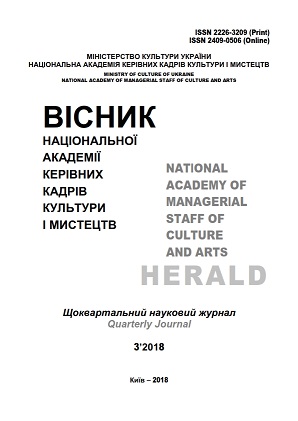Літургічний сакральний текст у середньовічній і новочасній європейській культурній парадигмі
Liturgical Sacral Text in the Medieval and Modern European Cultural Paradigm
Author(s): Olga Leonidivna ZosimSubject(s): Christian Theology and Religion, Cultural history, Music, Middle Ages, Modern Age, Philosophy of Religion, Hermeneutics, History of Art
Published by: Національна академія керівних кадрів культури і мистецтв
Keywords: liturgical music; sacred text; paradigm of culture; European cultural space; church sacraments; Middle Ages; Modern and Contemporary Period;
Summary/Abstract: The purpose of the research. The aim of the article is to create a coherent picture of the transformation of the forms of liturgical texts as representatives of the sacredness from the Middle Ages to the Contemporary Period in the context of the medieval and modern its paradigms. Research methodology is a combination of historical, cultural, comparative, liturgical, contextual methods, with the help of which the specificity of the liturgical texts of various Christian denominations from the Middle Ages to the present as representatives of the sacral was characterized. Scientific novelty of the work lies in the fact that in Ukrainian science for the first time the mechanisms of transformation of the forms of sacred texts in liturgical music from the Middle Ages to the Modern and Contemporary Period were shown. Conclusions. In the Middle Ages the sacred text of the divine service appears as a syncretic unity of the verbal and transcendent, where the latter is represented through the aesthetic component. Religious communication in medieval divine service is accomplished through the transcendental dimension of the sacrament of the Eucharist, in which the prayermeditative function is a priority, and the proclamation of the Word of God is in the background. The anthropocentric dimension of the culture of the Modern Period has modified the form of the manifestation of the sacredness in the church art, which led to the separation of the verbal component from the transcendent and, accordingly, from the aesthetic. In the new Protestant churches the modification is associated with the rejection of the sacrament as a transcendent dimension of the rite and is marked by the strengthening of the verbal factor through the proclamation of the Word of God in the sermon. In traditional churches, while maintaining the classical sacramental theology, there is a two-vector approach to the use of liturgical texts, where during the XVII–XX centuries actual become services alternately either in sacral or in national languages.
Journal: Вісник Національної академії керівних кадрів культури і мистецтв
- Issue Year: 2018
- Issue No: 3
- Page Range: 288-293
- Page Count: 6
- Language: Ukrainian

